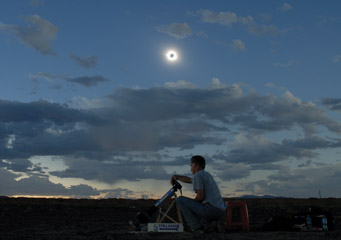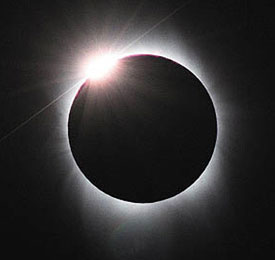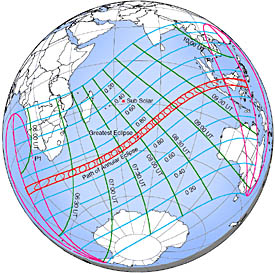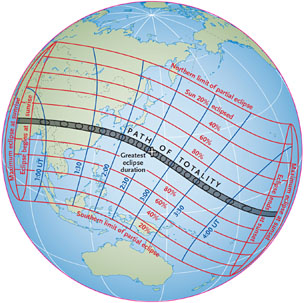This year will offer an interesting turn of events for eclipse watchers. February 2008 marked the third total lunar eclipse within a 12-month span, yet this year there will be none at all. (In fact, the next total eclipse of the Moon won't take place until December 20–21, 2010.)

Few events in nature offer the drama and spectacle of a total solar eclipse, as with this one seen over China on August 1, 2008.
S&T: Dennis di Cicco
But the news isn't all bad! On July 22nd, well-placed observers will enjoy the total solar eclipse of the century — a chance to stand in the Moon's shadow for more than 6.6 minutes. There'll also be an annular (ring) solar eclipse in January, as well as four partial lunar eclipses scattered throughout the year.
A solar eclipse can only happen at new Moon, when the lunar disk passes directly between Earth and the Sun. Conversely, a lunar eclipse occurs during full Moon, when our satellite passes through Earth's shadow. These coverups don't occur at every new and full Moon because the lunar orbit is tipped about 5° to Earth's orbital plane — only occasionally do the Sun, Earth, and Moon line up exactly enough for an eclipse to occur.
Three types of lunar eclipse are possible (total, partial, and penumbral) depending on how deep the full Moon plunges into or near the umbra, our planet's dark, central shadow. If it goes all the way in, we see a total lunar eclipse that's preceded and followed by partial phases. If the Moon skims part way into the umbra, only the partial phases occur. And if its disk passes just outside the umbra, it still encounters the weak penumbral shadow cast by Earth. No matter which type occurs, a lunar eclipse is observable anywhere on Earth where the Moon is above the horizon.

Johnny Horne of the Fayetteville Observer-Times captured this magnificent image of the famed "diamond ring" during the total solar eclipse of February 26, 1998. A Sky & Telescope contributing photographer, Horne observed the event from the deck of Holland America Line's Statendam.
Because the Moon casts a smaller shadow than Earth does, eclipses of the Sun require observers to be in the right place at the right time. If the Moon completely hides the Sun, even for a moment, the eclipse is considered total. With its brilliant disk completely covered, the Sun's ghostly white outer atmosphere is momentarily revealed for anywhere from seconds to several minutes.
However, this totality can only be viewed a narrow track or path on Earth's surface. Outside that path, about half the world is able to watch a partial eclipse as the Moon obscures a portion of the Sun.
Occasionally the Moon passes directly in front of the Sun but doesn't completely cover it. This odd-sounding situation is an annular eclipse, so-called because you can see a ring, or annulus, of sunlight surrounding the lunar disk. But an annular's path is likewise narrow, and outside of it observers see only a partial coverup.
Below are brief descriptions of this year's eclipses of the Sun and Moon. You'll find more details on this website and in Sky & Telescope magazine as the date of each draws near. Times are in Universal Time (UT) except as noted.

The annular eclipse of the Sun on January 26, 2008, will track across the Indian Ocean, making landfall only over the islands of southeastern Asia. Click on the image for a larger view.
January 26: Annular Eclipse
The year kicks off with a ring eclipse whose path falls almost entirely over the Indian Ocean. That's too bad, because the path is a rather generous 200 miles (300 km) wide, and at mid-eclipse (7:59 UT) you'd enjoy 7 minutes 54 seconds of annularity. The annular path clips the islands of Sumatra, Java, Borneo, and Celebes near its conclusion. Viewers in southern Africa, parts of Indonesia, and almost all of Australia have a chance to see the partial phases; from Cape Town, for example, about two-thirds of the Sun will be covered at 8:12 a.m.
February 9: Penumbral Lunar Eclipse
Oddly, there'll be four lunar eclipses in 2009 — none of which are total. February's event is just a penumbral skirting — no part of the lunar disk crosses the umbra. Still, you shouldn't have trouble spotting a dusky shading on the Moon's northern half from roughly 40 minutes before to 40 minutes after mid-eclipse, which comes at 14:38 UT. This timing means the event is observable in western North America before sunrise (and moonset); after sunset in eastern Europe and Africa; and closer to midnight in Asia and Australia.
July 7: Penumbral Lunar Eclipse
Compared to February's event, the one on July 7th is an eclipse in name only. The moon skims through too little of the penumbra to be noticed even by the most intent observer. Mid-eclipse occurs at 9:39 UT.
July 22: Total Solar Eclipse
Eclipse-chasers around the world are counting the days until July 22nd, when the lucky ones among them get to view longest total solar eclipse for the next 123 years. Totality is longest — 6 minutes 39 seconds — from a spot in the South Pacific Ocean. But many localities along the path get at least 5 minutes of darkness.

The longest total solar eclipse of the 21st century begins at dawn near the west coast of India and crosses southern China before heading out into the Pacific Ocean. Red lines denote regions where a partial eclipse is visible. Blue lines indicate mideclipse in Universal Time. Click on the image for a larger version.
Fred Espenak
The event begins just off India's west-central coast at 00:53 UT, then races eastward across the subcontinent. The Moon's shadow crosses Bhutan and clips Nepal, Bangladesh, and Burma (Myanmar) before reaching China. Chengdu, the capital of Sichuan province, lies within the path of totality, which also sweeps across Chongqing, Wuhan, and Hangzhou in southern China. Shanghai's 19 million inhabitants likewise lie in the path and should see about 5 minutes of totality at 1:39 UT (9:39 a.m. local time). Heading across the East China Sea, the path includes the Ryukyu Islands and Iwo Jima. No other major land masses experience totality, though much of east Asia, Indonesia, and the South Pacific are in line to see partial phases.
Click here for more details about this best-of-the-century spectacle.
August 6: Penumbral Lunar Eclipse
Fifteen days after July's fabulous solar eclipse (at new Moon), a barely-there penumbral lunar eclipse occurs (at full Moon). As was the case in July, this one won't be visible to the unaided eye. Mid-eclipse occurs at 00:39 UT.
December 31: Partial Lunar Eclipse
To round out the year, observers in the Eastern Hemisphere are treated to a partial lunar eclipse on New Year's Eve. The eclipse's midpoint occurs at 19:23 UT, when a slight umbral nick encroaches on the Moon's southern limb. Penumbral shading might be visible from about 45 minutes before that time until 45 minutes afterward.
July's total solar eclipse, as with the past few (Antarctica in 2003; Africa and western Asia in 2006; and Russia, Mongolia, and China in 2008) requires long-distance travel for North Americans. In fact, it's been quite a while since the continental U.S. experienced a total eclipse of the Sun. Here's a map showing future total solar eclipse paths over Canada, Mexico, and the United States through 2050. It shows that we Americans have several years' more wait ahead of us — until August 21, 2017, to be exact.
 0
0
Comments
You must be logged in to post a comment.